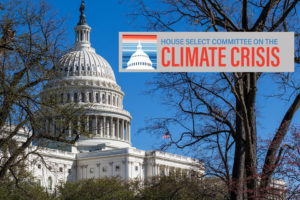 The U.S. House of Representatives Select Committee on the Climate Crisis is requesting information around policies that Congress should adopt to solve the climate crisis and adapt to the impacts of climate change. Committee staff told us they would welcome feedback from OEP experts. Four specific questions from the committee’s request for information are outlined below. We will compile and send to the committee substantive comments posted to this discussion by November 11.
The U.S. House of Representatives Select Committee on the Climate Crisis is requesting information around policies that Congress should adopt to solve the climate crisis and adapt to the impacts of climate change. Committee staff told us they would welcome feedback from OEP experts. Four specific questions from the committee’s request for information are outlined below. We will compile and send to the committee substantive comments posted to this discussion by November 11.
U.S. electricity generation from wind power is more than 7 times higher today than it was in 2017, and U.S. solar power generation is 100 times higher today than it was in 2009. However, annual carbon dioxide emissions have only decreased by 12% in this time frame, leaving a long way to go to reduce carbon dioxide emissions dramatically.
To accelerate the transition to a decarbonized economy, U.S. senators and congressmen have introduced dozens of bills this year. Among these bills is the Clean Energy Standard Act of 2019, which would institute a national standard requiring a certain percentage of a utility’s sales to come from clean energy technologies and establish a credit trading market for retail electricity sellers. Nearly three-quarters of U.S. states have adopted either a mandatory or a voluntary renewable portfolio standard, and these standards have been effective in increasing deployment of renewable energy.
Several other bills focus on driving down greenhouse gas emissions by factoring in the social cost of carbon to the price of energy. Three of these bills, which differ on how carbon tax revenues would be used, are the Energy Innovation and Carbon Dividend Act; the Climate Action Rebate Act; and the Raise Wages, Cut Carbon Act of 2019. Policymakers disagree as to what extent a carbon tax should be layered with other policies.
Even with a policy to encourage the use of renewables and other zero-carbon energy, other challenges remain, such as insufficient transmission lines. The best sites for utility-scale wind and solar power are often not near population centers and require new interstate transmission lines that can connect renewable energy to the grid. This challenge and others will need to be addressed as the energy transition moves forward.
1. Eminent domain for UNDERGROUND transmission lines, similar to how the Natural Gas Act has been so successful at accelerating the development & construction of new NG pipeline infrastructure. Overhead… Read more »
It is important that the fossil fuel companies that produce the majority of greenhouse gas emissions be addressed. A study produced by the Climate Accountability Institute claims that a mere… Read more »
1) Because U.S. and global emission continue to increase, the urgency to decarbonize over the next 20 years requires some dramatic changes. Some form of the following needs to be… Read more »
PS – In America, this New Low-Carbon Plan will require: – 500,000 MW of new wind (1.75 trillion kWhs/year) – 200,000 MW of new nuclear reactors, using SMRs that are especially ideal… Read more »
The only affordable option to reduce greenhouse releases is a carbon tax. The only politically viable carbon tax is one with a full rebate to every American citizen that also… Read more »
Before the US federal government passes policies to decarbonize the electric power sector, it should establish a task force of industry, government, and academic experts to develop a strategic plan… Read more »
The greatest need we have for decarbonizing our electricity supply is a clean and cost-effective means to supply backup power. It’s needed to convert intermittent “as available” wind and solar… Read more »
What policies should Congress adopt to decarbonize the electricity sector, consistent with meeting or exceeding net-zero emissions by mid-century? What analysis demonstrates that the recommended policies achieve that goal? I… Read more »
The big oil companies are the national oil companies of Saudi Arabia, China, and Russia. What the smaller western oil companies do (the big three western companies: Exxon, BP and… Read more »
Mr. Forsberg, Yes, China, Saudi Arabia, Russia and Iran lead Carbon Trackers list. but Exxon is number 5 of the 100 corporations who produced 71% of all carbon emissions since… Read more »
In posting to this blog and responding to the call by the House Select Committee on the Climate Crisis for citizen input, I ‘ve been disappointed to observe a response… Read more »
Thank you for all of your comments so far! We continue to welcome responses to the four questions in the discussion prompt through Monday, November 11. OurEnergyPolicy is also happy… Read more »
Climate Scientist James Hansen and I made a submission to the House Select Committee on the Climate Crisis that describes why Fee and Dividend is the preferred policy for putting… Read more »
The aim is to be on a 1.5°C pathway, the U.S. must achieve a net-zero carbon profile economy-wide by around mid-century, going negative thereafter. The availability of some kind of… Read more »